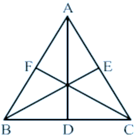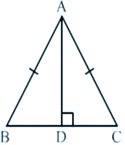Look at the statements given below:
I. If AD, BE and CF be the altitudes of a ΔABC such that AD = BE = CF, then ΔABC is an equilateral triangle.
II. If D is the mid-point of hypotenuse AC of a right ΔABC, then BD = AC.
III. In an isosceles ΔABC in which AB = AC, the altitude AD bisects BC.
Which is true?
A. I only B. II only
C. I and III D. II and III
We can clearly observe that statement I and statement III are correct.
We can prove the statement as follows:
In ∆ABC, altitudes AD, BE and CF are equal

Now, In ∆ABE and ∆ACF,
BE = CF (Given)
∠A = ∠A (common)
∠AEB = ∠AFC (Each 90°)
Therefore, by AAS axiom,
∆ABE ≅ ∆ ACF
AB = AC (by cpct)
In the same way, ∆BCF ≅ ∆BAD
thus, BC = AB (by cpct)
Therefore AB = AC = BC
Thus, ∆ABC is an equilateral triangle.
We can prove the IIIrd statement as follows:
Let ∆ABC be an isosceles triangle with AD as an altitude

Now, In ∆ABD and ∆ADC,
AB = AC (Given)
∠B = ∠C (Angles opposite to equal sides)
∠BDA = ∠CDA (each 90°)
Therefore by AAS axiom,
∆ABD ≅ ∆ADC
BD = DC (by congruent parts of congruent triangles)
∴ D is the mid-point of BC and hence AD bisects BC.